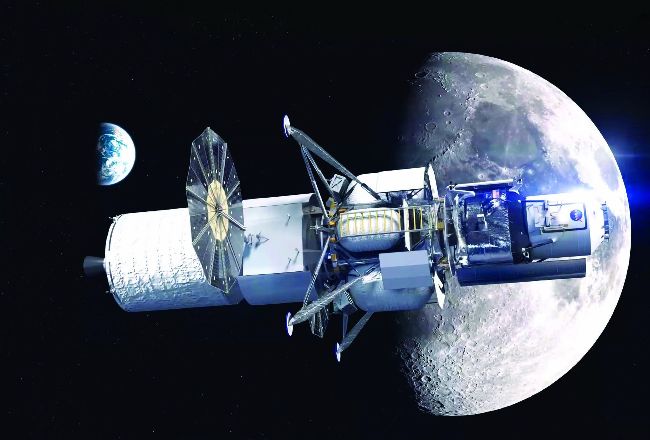Bird of a Feather
The “National Team” Wings Toward A Lunar Landing
by John F. Kross
Fifty years ago, Grumman engineers faced a nearly impossible task: cram tons of propellant and “watchmaker’s machinery” inside an eggshellthin fuselage and land it on the Moon. Working around the clock and thinking out of the box, they overcame the odds in July 1969 when the Lunar Module Eagle settled onto the Sea of Tranquility. Five more Apollo Lunar Modules followed including Falcon, the first to carry a lunar rover for extended exploration. Today, a new generation of engineers are grappling with the design of a crewed lunar lander for Project Artemis using lessons learned and updated technology to go back to the Moon and stay.
In April 2020, NASA awarded 10-month base period contracts (limited-time contracts that may be extended) for the Artemis human landing system (HLS) as part of a NextSTEP-2 announcement. Instead of a traditional cost-plus contract for one company, NASA proffered fixed-price awards to three industry teams to develop crewed landers through public-private partnerships modeled on NASA’s Commercial Orbital Transportation Services (COTS) program. In this scheme, NASA shares development costs and purchases services along with other customers.
The largest contract, worth 579 million dollars, went to the team spearheaded by Jeff Bezos’s company Blue Origin. The firm announced its intent to compete for the HLS program last year, joining forces with Lockheed Martin, Northrop Grumman, and Draper Labs in what it called a “National Team.” NASA also awarded HLS contracts to SpaceX and another group led by Dynetics that included Sierra Nevada Corporation and more than a dozen other companies. “This is the last piece that we need to get to the Moon,” said NASA Administrator Jim Bridenstine during the announcement. “Today, we’re going under contract with three companies that are going to take us all the way to the Moon.” Notably missing from the awardees was Boeing, whose proposal required two launches of the oft-delayed and costly Space Launch System (SLS).

Blue Origin’s National Team integrated lander design
Credit: Blue Origin
In making the awards, NASA specified three criteria: technical proficiency, price, and management ability (in descending order of importance). That is, technical factors were more important than cost, and cost outweighed management considerations. Each of the three proposals had benefits and drawbacks, with the National Team winning praise for their partnership approach and having no significant weaknesses apart from the propulsion systems. In NASA’s view, their “teaming approach,” drawing upon heritage hardware, increased the odds of meeting the 2024 deadline. The agency also lauded the National Team’s “strong commercial approach” to “accelerate the development of a cislunar economy.” Low cost was another feather in their cap.